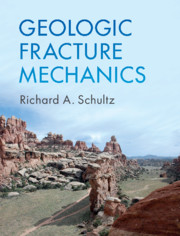Book contents
- Geologic Fracture Mechanics
- Geologic Fracture Mechanics
- Copyright page
- Dedication
- Contents
- Preface
- Acknowledgements
- 1 Introduction to Geologic Structural Discontinuities
- 2 Elastic Rock Rheology and Stress Concentration
- 3 Stress, Mohr Circles, and Deformation at Peak Strength
- 4 Cracks and Anticracks
- 5 Discontinuity Patterns and Their Interpretation
- 6 Faults
- 7 Deformation Bands
- 8 Fracture Mechanics: A Tour of Basic Principles
- 9 Beyond Linear Elastic Fracture Mechanics
- Glossary
- References
- Index
- Answers to Selected Exercises
1 - Introduction to Geologic Structural Discontinuities
Published online by Cambridge University Press: 03 August 2019
- Geologic Fracture Mechanics
- Geologic Fracture Mechanics
- Copyright page
- Dedication
- Contents
- Preface
- Acknowledgements
- 1 Introduction to Geologic Structural Discontinuities
- 2 Elastic Rock Rheology and Stress Concentration
- 3 Stress, Mohr Circles, and Deformation at Peak Strength
- 4 Cracks and Anticracks
- 5 Discontinuity Patterns and Their Interpretation
- 6 Faults
- 7 Deformation Bands
- 8 Fracture Mechanics: A Tour of Basic Principles
- 9 Beyond Linear Elastic Fracture Mechanics
- Glossary
- References
- Index
- Answers to Selected Exercises
Summary
Planar breaks in rock are one of the most spectacular, fascinating, and important features in structural geology. Joints control the course of river systems, the extrusion of lava flows and fire fountains, and modulate groundwater flow. Joints and faults are associated with bending of rock strata to form spectacular folds as seen in orogenic belts from British Columbia to Iran, as well as seismogenic deformation of continental and oceanic lithospheres. Anticracks akin to stylolites accommodate significant volumetric strain in the fluid-saturated crust. Deformation bands are pervasive in soft sediments and in porous rocks such as sandstones and carbonates, providing nuclei for fault formation on the continents. Faults also form the boundaries of the large tectonic plates that produce earthquakes—and related phenomena such as mudslides in densely populated regions such as San Francisco, California—in response to tectonic forces and heat transport deep within the Earth. Faults, joints, and deformation bands have been recognized on other planets, satellites, and/or asteroids within our Solar System, attesting to their continuing intrigue and importance to planetary structural geology and tectonics.
- Type
- Chapter
- Information
- Geologic Fracture Mechanics , pp. 1 - 26Publisher: Cambridge University PressPrint publication year: 2019
- 1
- Cited by



